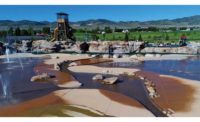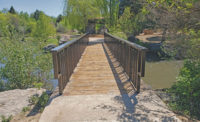Hal and Berni Hanson Regional Park
Aldie, Va.
BEST PROJECT
Submitted By: HESS Construction Co.
Owner: Loudoun County, Dept. of Transportation & Capital Infrastructure
Lead Design Firm: Lose Associates
General Contractor: HESS Construction Co.
Civil Engineer: Bowman Consulting
Structural Engineer: Ehlert Bryan Inc.
MEP Engineer: b2E Consulting Engineers P.C.
Subcontractors: Heritage Mechanical; Helix Electric
Loudoun County, Va.’s newest park brings the greater community a wide array of recreational and amenity spaces. The nearly $83-million project includes 10 soccer fields, four baseball diamonds with batting cages and dugout facilities, a dedicated cricket pitch, four tennis courts and two synthetic turf fields with grandstands. Other features include an outdoor basketball court, two playgrounds and a splash pad.
A skate park, five ponds with fishing piers, a main lodge and a nature center add educational and immersive experiences. The park also includes picnic pavilions, paved and mulched trails, two off-leash dog areas, a disc golf course, an amphitheater and a restored existing farmhouse. To further enhance visitor comfort, concession, restroom and administrative buildings are available.

Photo by Ken Wyner, courtesy of HESS Construction Co.
Careful management was vital given the presence of wetlands and protected areas. The team completed several major site developments, including full irrigation systems, field lighting, two new signalized intersections and local road improvements, all aimed at enhancing the park’s accessibility and functionality.
With such an expansive footprint—split by a highway—the contractor took extra care to ensure a large enough project team to cover the area and its many individual structures. Communication and collaboration with trade contractors were pivotal in addressing that challenge.
To enhance safety and efficiency, the contractor used a drone to perform remote inspections of inaccessible areas as well as construction safety monitoring and site surveillance of the 257-acre construction site. By capturing video footage and identifying potential hazards in hard-to-reach locations, the drone enabled the team to closely monitor and manage the entire project.
A site-specific safety plan helped address challenges such as overhead power lines, the large jobsite footprint, a busy roadway, a nearby occupied school and neighborhoods. Ongoing training efforts included site-specific safety orientations, daily huddles to communicate daily operations and hazards and weekly toolbox talks. Each trade had an OSHA-30 trained supervisor and two first aid and CPR-certified employees on site.

Photo by Ken Wyner, courtesy of HESS Construction Co.
During the construction phase, the contractor turned to a three-phase quality assurance program. The first phase confirmed that each trade contractor fully understood their responsibilities and expectations for quality as defined by the contract conditions, plans, specifications and work scope. A second phase ensured that materials were fabricated in accordance with contract documents and coordinated with the work of other trade contractors. The third phase involved a continuous process to monitor and inspect each aspect of work until completion and ensured a consistent, acceptable level of quality and workmanship.
Throughout the quality control program, the contractor facilitated trade contractor coordination and ensured that all design clarifications were implemented properly.

Photo by Ken Wyner, courtesy of HESS Construction Co.




